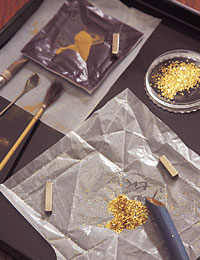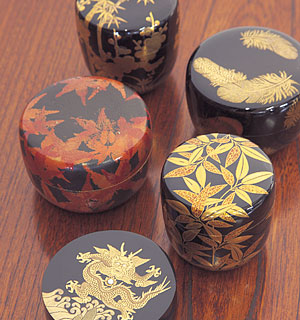Special Feature![]() “Japan, the Land of Gold.” How True Is the Old Legend?
“Japan, the Land of Gold.” How True Is the Old Legend?
Gold dust sprinkled on lacquer
Omote Masanori, maki-e artisan
Maki-e are “sprinkled pictures,” gold powder sprinkled to make decorative pictures on lacquer. The technique is uniquely Japanese.
Some of Japan’s most famous maki-e lacquer ware comes from Kanazawa, Wajima and Yamanaka, three places in Ishikawa Prefecture.
Omote Masanori has been making maki-e for half a century using the Yamanaka-nuri technique. His hands move carefully, precisely sketching a design on a lacquered container. Then he takes a bamboo tube and sprinkles gold powder from it onto the still-wet surface. He uses different particle sizes to give his illustrations a finer touch. “First I sprinkle on the larger particles, and make sure they don’t pile up one on the other. Then I fill in the gaps with small particles.”
He wipes off the excess with a brush. The sprinkling, wiping off and sprinkling again continues for some time.
When the lacquer dries, the entire container is covered with a thin coating of black lacquer, then dried again for more than a week. Next comes the togi-dashi process—burnishing the lacquer with charcoal to bring out the maki-e illustration.
“I rub it with charcoal for half a day, then dry it for one day, then rub again. Lacquer doesn’t dry quickly, so there’s a lot of waiting involved.”
After the final rubbing the maki-e is finished. Flowers shine against the darkness of the lacquer background.
“When an order is ready, I find it really hard to part with it. I suppose I could make doubles, and keep one for myself each time, but I can’t spare the time....”
He picks up one of his hand-made creations, his eyes showing he will have a hard time saying good-bye to it. ![]()



